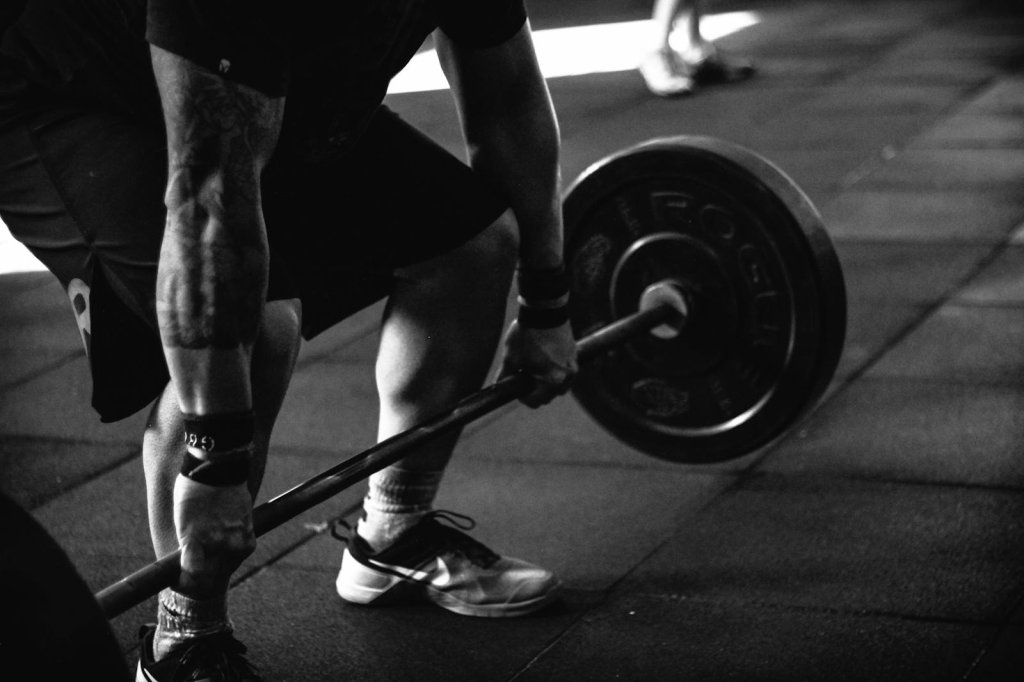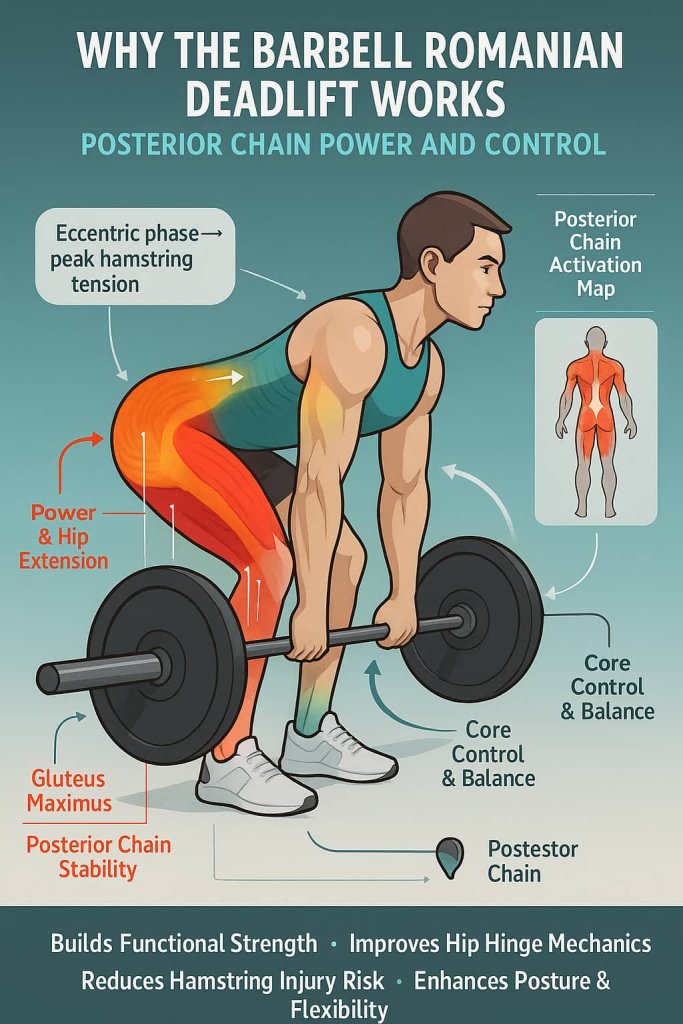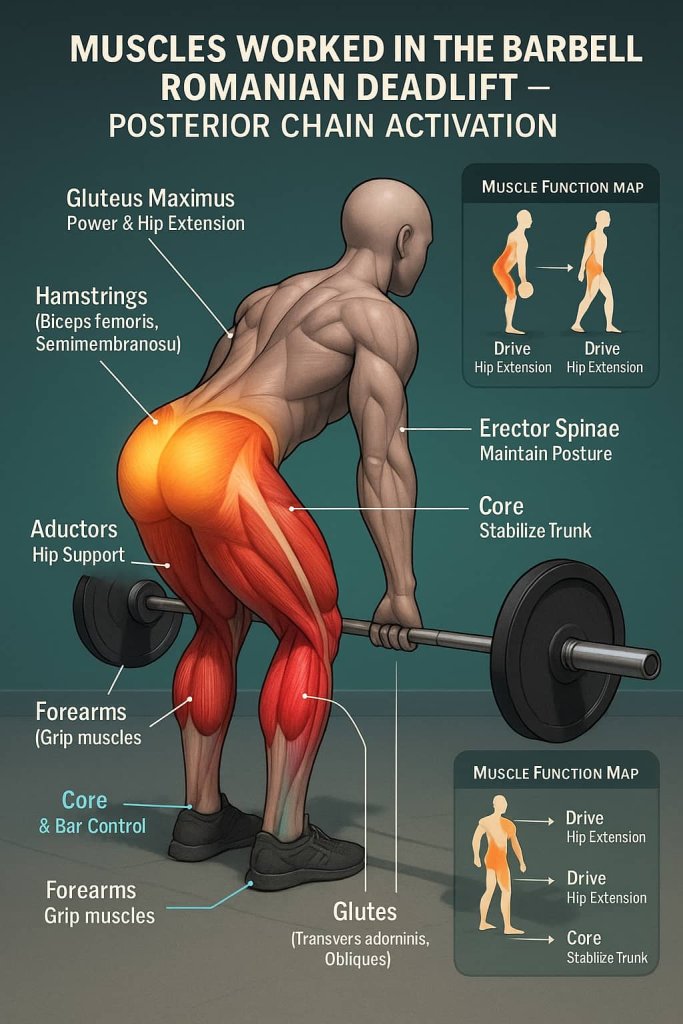The Barbell Romanian Deadlift (RDL) is one of the most effective exercises for strengthening your glutes, hamstrings, and improving posture.
Unlike a conventional deadlift, which starts from the floor, the RDL focuses on the eccentric (lowering) phase of the hip hinge, emphasizing muscle control, stability, and flexibility through the posterior chain.

Understanding this movement is key for athletes, bodybuilders, and anyone seeking better lower-body strength or injury prevention. It enhances hip mobility, improves balance, and supports long-term spinal health — making it a must-have in any strength-training program.
Why the Barbell Romanian Deadlift Works
The barbell RDL isolates and strengthens the posterior chain — the powerhouse of athletic performance. By maintaining slight knee flexion and focusing on hip hinge mechanics, it builds functional strength and enhances coordination between the glutes, hamstrings, and lower back.

Research Insight:
- A 2023 Frontiers in Physiology study confirmed that eccentric hamstring training, such as the RDL, significantly reduces injury risk and improves muscle strength balance.
Key Benefits:
- Builds posterior-chain strength for athletic performance.
- Improves hip hinge mechanics and posture.
- Reduces risk of hamstring strains and lower-back pain.
- Increases flexibility through controlled eccentric loading.
How to Do the Barbell Romanian Deadlift
Setup:
- Stand with your feet hip-width apart, barbell resting against your thighs.
- Hold the barbell with an overhand grip, hands just outside your thighs.
- Slightly bend your knees and keep your spine neutral.
Movement:
- Hinge at the hips, pushing them back as you lower the barbell.
- Keep the bar close to your legs throughout the descent.
- Lower until you feel a deep stretch in your hamstrings (usually mid-shin level).
- Drive your hips forward to return to the standing position without rounding your back.
Breathing:
- Inhale on the way down.
- Exhale as you drive your hips forward and return upright.
Muscles Worked in the Barbell Romanian Deadlift
| Primary Muscles | Supporting Muscles |
|---|---|
| Gluteus Maximus | Erector Spinae |
| Hamstrings (Biceps Femoris, Semitendinosus, Semimembranosus) | Adductors |
| Core (Transverse Abdominis, Obliques) | |
| Forearms & Grip Muscles |

Muscle Function:
- Hamstrings: Control the descent and drive hip extension during the lift.
- Glutes: Provide power and stability at the top of the movement.
- Erector Spinae: Maintain spinal alignment and posture.
- Core: Stabilizes the trunk throughout the hinge motion.
Trainer Tip
- Focus on hinging at your hips — not squatting.
- Keep your lats engaged to stabilize the bar path.
- Avoid hyperextending your spine at the top.
- Control the lowering phase for maximum hamstring tension.
Common Mistakes to Avoid
- Bending the knees too much – turns the move into a squat.
- Rounding the back – increases risk of lumbar strain.
- Lowering too far – once your hamstrings stretch fully, stop.
- Letting the bar drift away – always keep it close to your legs.
- Rushing the eccentric phase – slow, controlled movement yields better results.
Programming Guidelines
- Frequency: 1–2 times per week
- Sets & Reps: 3–4 sets of 6–10 reps
- Load: Moderate to heavy, maintaining perfect form
- Tempo: 3–4 seconds lowering (eccentric), 1 second lift (concentric)
- Rest: 60–90 seconds between sets
Progression Tips:
- Increase load gradually (2–5% weekly).
- Combine with accessory moves like glute bridges, Nordic curls, or good mornings for balance.
Variations & Progressions
1. Bodyweight Single-Leg Romanian Deadlift (SLRDL)
Why it works:
The Bodyweight SLRDL develops balance, hip stability, and posterior chain control without external weight. It teaches proper hip-hinge mechanics and strengthens stabilizing muscles on each side independently. Research in the International Journal of Sports Physical Therapy (2025) found that athletes performing single-leg hinges like the SLRDL had a 66% lower risk of hamstring strain injuries.
Muscles worked:
- Primary: Gluteus maximus, hamstrings
- Secondary: Core (obliques, transverse abdominis), adductors, calves, and foot stabilizers
How to do it:
- Stand tall with feet hip-width apart and shift weight onto one leg.
- Engage your core and hinge at the hips, extending your opposite leg straight behind you.
- Keep your back flat and arms extended toward the floor for balance.
- Lower until you feel tension in your hamstring, then drive your hips forward to return upright.
- Repeat all reps on one side before switching.
Trainer Tip:
Focus on maintaining a straight line from head to heel as you hinge. Keep your hips square — avoid opening the raised leg outward.
2. Dumbbell Romanian Deadlift
Why it works:
This variation increases stability demand and balance while allowing for a greater range of motion compared to the barbell. Using dumbbells also lets you move freely at the shoulders, reducing strain and encouraging symmetrical strength development.
Muscles worked:
- Primary: Hamstrings, glutes
- Secondary: Core, erector spinae, forearms
How to do it:
- Hold a dumbbell in each hand in front of your thighs, palms facing you.
- Keep knees slightly bent and hinge at your hips, lowering the weights toward mid-shin.
- Maintain a flat back and tight core throughout.
- Pause at the bottom, then return to standing by squeezing your glutes.
Trainer Tip:
Use mirrors or video feedback to ensure both dumbbells move evenly. Focus on a slow, controlled descent to increase muscle engagement.
3. Single-Leg Romanian Deadlift (Weighted)
Why it works:
Adding a dumbbell or kettlebell to the Single-Leg RDL enhances balance, coordination, and unilateral strength. It’s excellent for addressing muscle imbalances and developing core stability.
Muscles worked:
- Primary: Gluteus maximus, hamstrings
- Secondary: Obliques, erector spinae, and stabilizing muscles of the ankle and foot
How to do it:
- Hold a dumbbell or kettlebell in the opposite hand of the working leg.
- Engage your core and hinge at your hips while extending the non-working leg straight behind.
- Keep your back flat and lower the weight slowly until your torso is parallel to the ground.
- Push through the heel of your standing leg to return upright.
Trainer Tip:
Start with bodyweight first to master control. Focus on “reaching” your extended leg back rather than leaning forward from the torso.
4. Snatch-Grip Romanian Deadlift
Why it works:
This advanced variation widens your grip on the barbell, increasing demand on your upper back, traps, and lats while still challenging your hamstrings and glutes. It builds total posterior chain strength and improves posture.
Muscles worked:
- Primary: Hamstrings, glutes, erector spinae
- Secondary: Lats, trapezius, rear deltoids, forearms
How to do it:
- Stand with feet hip-width apart and grip the barbell with a snatch-width grip (wider than shoulder width).
- Keep knees soft and hinge at the hips while keeping the bar close to your legs.
- Lower until your torso is nearly parallel to the floor.
- Drive hips forward and return to standing tall.
Trainer Tip:
Focus on scapular retraction — pull your shoulder blades down and back. This maintains upper-back tension and protects your shoulders.
5. Deficit Romanian Deadlift
Why it works:
Standing on a low platform increases your range of motion, amplifying hamstring stretch and glute engagement. It’s a progression for advanced lifters seeking improved flexibility and strength through a greater hinge depth.
Muscles worked:
- Primary: Hamstrings, glutes
- Secondary: Core, erector spinae, adductors
How to do it:
- Stand on a small platform (2–4 inches high) with a barbell or dumbbells in hand.
- Keep a soft bend in your knees and hinge at your hips to lower the weight below foot level.
- Maintain a neutral spine and tension in your hamstrings.
- Drive hips forward to stand tall without rounding your back.
Trainer Tip:
Use a moderate load — going too heavy reduces control and increases risk. Prioritize form and flexibility over weight.
6. Banded Romanian Deadlift
Why it works:
The resistance band adds progressive tension throughout the movement, forcing your glutes and hamstrings to work harder near lockout. This improves hip extension power, making it excellent for athletes and sprinters.
Muscles worked:
- Primary: Gluteus maximus, hamstrings
- Secondary: Erector spinae, lats, and core
How to do it:
- Anchor a resistance band under your feet and loop it around your shoulders or barbell.
- Hold the bar or band tension at thigh level with a firm grip.
- Hinge at your hips, lowering until you feel hamstring stretch.
- Drive your hips forward against band tension to return to the top.
Trainer Tip:
Control the descent — the band will try to “snap” you upward. Focus on resisting the pull to build eccentric strength and control.
Safety & Precautions
- Warm up with dynamic hamstring and hip stretches.
- Avoid heavy loading without proper mobility.
- Keep a flat back and neutral head position at all times.
- If you experience sharp pain, stop immediately and consult a qualified trainer or physiotherapist.
Warm-Up Before Barbell RDLs
Perform 5–10 minutes of dynamic mobility before lifting:
- Hip Circles (10 reps each direction)
- Cat-Cow Stretches (10 reps)
- Bodyweight Good Mornings (15 reps)
- Leg Swings (10–15 per side)
- Light Barbell RDL Warm-Up Set (15 reps)
FAQs
1. What’s the difference between Romanian Deadlift and Conventional Deadlift?
The RDL starts from a standing position and focuses on the eccentric lowering phase, while the conventional deadlift starts from the floor and emphasizes concentric drive.
2. Can beginners do the barbell RDL?
Yes, but start light (e.g., just the bar) and prioritize form before adding weight.
3. Should I feel the RDL in my lower back?
You’ll feel some engagement, but if there’s pain, it usually indicates poor hinge form or overextension.
4. How low should I go?
Stop when you feel a deep hamstring stretch without rounding your back — typically around mid-shin.
5. Is the RDL safe for people with back pain?
It can be, if done with proper form and under professional supervision, as it strengthens spinal stabilizers.
6. What grip should I use?
Double overhand is best for control; switch to mixed or hook grip if grip strength limits performance.
7. Can RDLs replace leg curls?
Yes, RDLs train hamstrings through functional movement, making them superior for real-world strength.
Conclusion
The Barbell Romanian Deadlift is a cornerstone movement for anyone serious about strength, mobility, and injury prevention. It teaches proper hip mechanics, builds powerful glutes and hamstrings, and enhances overall posture.
Add it consistently to your program, progress patiently, and you’ll notice major gains in strength and movement quality.
References
- Lee et al., 2018 — EMG & Kinetics: Conventional Deadlift vs Romanian Deadlift
Helps distinguish where the RDL emphasizes hamstrings vs. conventional deadlift mechanics.
Read on PubMed Central - Coratella et al., 2022 — EMG: Romanian vs Step-RDL vs Stiff-Leg Deadlift
Posterior-chain activation across hinge variations; supports “Why it works/Muscles worked.”
Read on MDPI - Martín-Fuentes et al., 2020 — EMG Review of Deadlift Variants
Summarizes activation patterns; notes similarities/differences with Good Morning and RDL.
Read on PMC - Hu et al., 2023 — Meta-analysis: Eccentric Hamstring Training & Injury Reduction
Shows ~46% reduction in hamstring injuries—supports the RDL’s eccentric emphasis.
Read on PubMed - NSCA — Romanian Deadlift (Exercise Technique Manual excerpt)
Authoritative coaching cues and safety for YMYL compliance.
Read on NSCA - Otani et al., 2025 — Cohort Study: Single-Leg RDL & Hamstring Strain Risk
Supports inclusion of SLRDL in warm-ups/progressions for risk management.
Read on PubMed
